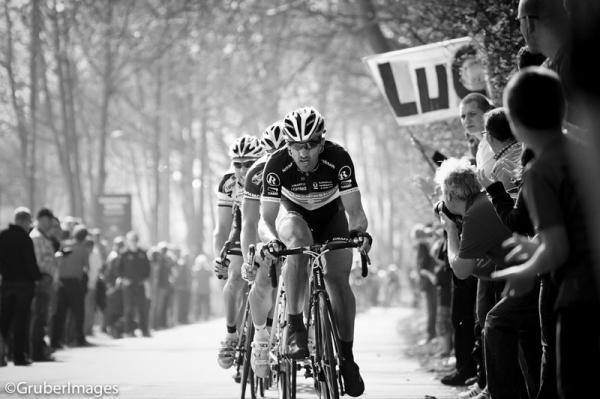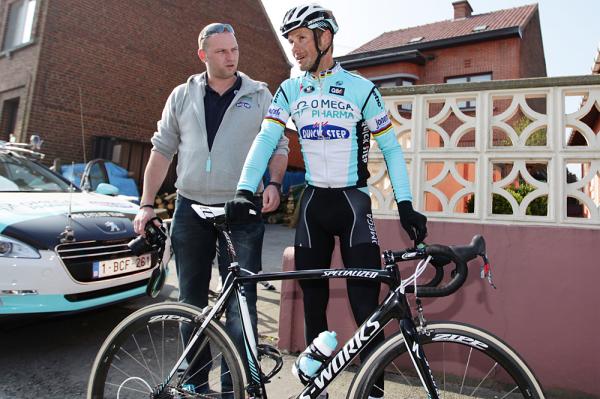Prize fight in Flanders: Boonen versus Cancellara
A recap of seven years of dominance on the cobbles



The expectation has been growing in Flanders all week. In cafes on cobbled squares, newspapers are scrutinised and brows are furrowed. The debates rage fore and aft in bars and restaurants. Rooms fall into hushed reverence for television sports bulletins. The order changes, but the names uttered are always the same. Boonen and Cancellara or Cancellara and Boonen. The Ali and Frazier of recent Tour of Flanders history.
In the blue corner, Tom Boonen, backed by the powerful Omega Pharma-QuickStep squad. A son of Flanders with his rapid sprint restored after a troubled brace of seasons, he approaches Sunday’s race with his appetite whetted rather than sated by victories in E3 Harelbeke and Gent-Wevelgem last week.
In the red corner, Fabian Cancellara, leader of the merged RadioShack-Nissan team, but often left to his own devices in the finale. The Swiss champion enters the cobbled classics still smarting from the disappointment of last spring, when he won the strongest man contest but watched others carry off the real prizes. That the scenario repeated itself at Milan-San Remo can only have added to his sense of injustice.
Boonen has two Tours of Flanders to Cancellara’s one and three Paris-Roubaix titles to Cancellara’s two, yet Cancellara’s all-conquering campaign of 2010 felt like it would prove the defining moment in their struggle for pre-eminence. Instead, he fell short of the big prizes in 2011, and Boonen has since picked himself back off the canvass.
Little wonder then, that all of Flanders is preparing for a prize fight between two men who have dominated proceedings in the cobbled classics since Johan Museeuw hung up his wheels in 2004. Between them, they have won eight of the fourteen editions of the Tour of Flanders and Paris-Roubaix since then, while their teammates have mopped up another three. The lesson is clear: Cancellara or Boonen might not necessarily win on Sunday, but if recent history is any guide, the blows they land will decide the outcome of the race.
2005: Tommeke emerges
The classics crown was already being lowered onto Boonen’s head following Museeuw’s retirement when Tommeke impetuously grabbed it with both hands and completed the coronation himself by rattling off a Flanders-Roubaix double at the precocious age of 24. His Flanders triumph was a testament to his youthful verve, as he nonchalantly soloed clear of Erik Zabel, Andreas Klier and Peter Van Petegem after the Bosberg to take an emphatic win in Meerbeke. A week later, he repeated the deed by sprinting to victory on the velodrome at Roubaix.
Get The Leadout Newsletter
The latest race content, interviews, features, reviews and expert buying guides, direct to your inbox!
By contrast, it was a rather more low-key spring for Cancellara, in his final year at Fassa Bortolo, and 8th at Paris-Roubaix and 4th at Gent-Wevelgem were the best he had to show for his efforts. A respectable showing from a young rider, but wholly overshadowed by the haul of Boonen, who added a world title for good measure in September, sparking giddy speculation as to what he might achieve in races as diverse as Liège-Bastogne-Liège and even the Tour de France.
2006: Honours even
Bedecked in the rainbow jersey, failure was simply not an option for Boonen in 2006 in the eyes of an expectant Flemish public, and after snapping up victory at E3 Harelbeke, his Ronde win the following week was almost routine. When Leif Hoste jumped on the Valkenberg, Boonen ambled across and then easily dispatched the Discovery Channel rider to win in Meerbeke with King Albert II of Belgium watching approvingly from the tribune of honour.
Seven days later, and now wearing the combined colours of world champion and ProTour leader, Boonen was the overwhelming favourite to add another Paris-Roubaix to his palmares. Instead, his air of impregnability was dealt a significant blow by a resurgent Fabian Cancellara, now under the guidance of Bjarne Riis at CSC. The Swiss rider simply took flight with 20km to go, dropping Vladmir Gusev at the Carrefour de l’Arbre and cruising to his first classics victory.
Boonen rolled across the line in 5th, and even if the disqualification of three riders for passing through a closed level crossing elevated his to the second step on the podium he must have sensed that the man standing to his left would prove a fly in the ointment in years to come. "I'm not disappointed,” Boonen insisted. “It's good that everyone realises that I'm not a robot. Losing can be a better lesson than winning."
2007: Stalemate
Both Boonen and Cancellara would draw plenty of lessons from a 2007 cobbled campaign that began brightly, with Boonen outsprinting Cancellara at Harelbeke. At Flanders, however, Boonen was unable to react when Alessandro Ballan and Leif Hoste went clear on the Muur and came home in a discreet 12th, while Cancellara had burned himself up by going on the offensive as early as the climb of the Berendries. In spite of his undoubted strength, he was still some way short of the behemoth that terrorises the classics peloton today, and paid a price for his aggression, rolling home in 53rd.
An unusual edition of Paris-Roubaix a week later saw both Cancellara and Boonen come up short. In unseasonably warm temperatures, Cancellara’s CSC teammate Stuart O’Grady survived from the early break to take a surprise win as the main favourites were locked in stalemate behind: 6th place for Boonen and 19th for Cancellara. “If everyone rides on my wheel, it becomes difficult to win Paris-Roubaix again,” Cancellara said darkly afterwards. He would have to start getting used to it.
2008: The emperors strike back
Cancellara had already removed the pressure from his shoulders as the cobbled classics approached in 2008 after he took the smartest victory of his career at Milan-San Remo. By contrast, nondescript showings at Het Volk and E3 Harelbeke meant that Boonen had no such insurance policy as Holy Week approached, but he still showed admirable poise at the Tour of Flanders. After teammate Stijn Devolder clipped off the front on the Eikenmolen, Boonen dutifully marked the moves behind and rolled in alongside Cancellara 21 seconds back, while Devolder took full advantage of the tactical stalemate to triumph in Meerbeke.
The following week’s Paris-Roubaix saw Boonen and Cancellara finally square up to one another as part of the same breakaway in a monument, with Alessandro Ballan coming along for the ride. In spite of the ferocity of Cancellara’s initial attack at Templeuve, Boonen rallied the storm and there was an air of formality about the way he swooped clear on the velodrome to take his second Roubaix win. “Cancellara had cramps up to his ears, and Ballan was just happy that he wasn't dropped on the Carrefour de l'Arbre,” a confident Boonen said. “If you know that, you need to be a realist, you shouldn't be the smart-ass that attacks them."
2009: Boonen the standard
2009 hinted at an underlying truth to the cobbled classics of the recent past: Tom Boonen is the standard, and in the absence of extraordinary performances from other quarters, the Belgian or his QuickStep team generally wins. A broken chain on the Koppenberg ended Cancellara’s challenge at Flanders, where Boonen dutifully man-marked Filippo Pozzato as teammate Stijn Devolder soared to an unexpected second successive victory.
A sub-par Cancellara was distanced with over 40km still to go at Paris-Roubaix the following week, where Boonen delivered arguably the finest display of his career. Setting a hyperactive pace through almost every cobbled section in the finale, he rid himself of Pozzato and Thor Hushovd and soloed into the velodrome. “As a performance I rate this as high as my first win in the Tour of Flanders, possibly even higher," said Boonen, who appeared set to continue his domination for years to come.
2010: The turning point?
After the previous year’s disappointment, it was a very different Cancellara who showed up in Belgium in 2010. The clinical way in which he dispatched of Boonen at Harelbeke meant that a cloud of foreboding hung over Flanders in the week before the Ronde, and the home fans’ worst fears were duly realised on the Muur. In a show of force that launched a thousand internet conspiracy theories, a seated Cancellara simply rode the Boonen off his wheel after the pair had broken clear on the Molenberg.
The Belgian champion toppled in his own demesne, it seemed a watershed moment in the rivalry. There was a grim inevitability about Paris-Roubaix seven days later, but the manner of Cancellara’s win still outstripped all expectations as he cruised away – again seated – approaching the pavé Mons-en-Pévèle with almost 50km to go. Boonen had attempted to go clear in the preceding 10km, but finished the day demoralised, over 3 minutes down in 5th. "Boonen's attacks didn’t bother me and I didn't want to play his game. He tried to do his race and I did mine," said Cancellara.
2011: Pyrrhic victories
A crushing E3 Harelbeke win meant that Cancellara was the overwhelming favourite for De Ronde, and he looked to repeat the dose by charging up the road on the Leberg. In dragging QuickStep’s Sylvain Chavanel along with him, however, he soared too close to the sun, and the wax melted on the slopes of the Muur as dehydration set in. It seemed to be advantage Boonen as a ten-man lead group headed towards Meerbeke together, but Cancellara summoned up the reserves to go clear again with Chavanel and eventual winner Nick Nuyens. Boonen jumped away for fourth just behind, but was denied the win by Cancellara’s decision to open the sprint early to ensure his place on the podium.
“I lost by trying to win, the others rode only to make me lose,” Cancellara lamented afterwards, and he would come away from Paris-Roubaix with a similar complaint. Heavily marked as Johan Vansummeren’s winning break sallied clear, Cancellara took a frustrated second place and he cut a disconsolate figure at the Roubaix velodrome. For his part, Boonen had endured an even more disappointing outing – mechanical problems at the Forest of Arenberg ended his challenge.
Cancellara’s main rival in 2011 was his own reputation rather than Boonen: blighted by nagging knee problems, one was left to wonder if the Belgian’s best years were behind him. Yet for all Cancellara’s pyrotechnics, Boonen still came away from the cobbled classics with as many victories, thanks to his triumph at Gent-Wevelgem. Small beer compared to the bigger prizes, perhaps, but a significant sign that there was still some fight left in Boonen all the same.
A year on, amid Cancellara's continued feats of strength, Boonen's rejuvenation and the remarkable resurgence of his Omega Pharma-QuickStep team, all signs again point to the Old Firm deciding the order of business for the next two Sundays.

Barry Ryan was Head of Features at Cyclingnews. He has covered professional cycling since 2010, reporting from the Tour de France, Giro d’Italia and events from Argentina to Japan. His writing has appeared in The Independent, Procycling and Cycling Plus. He is the author of The Ascent: Sean Kelly, Stephen Roche and the Rise of Irish Cycling’s Golden Generation, published by Gill Books.